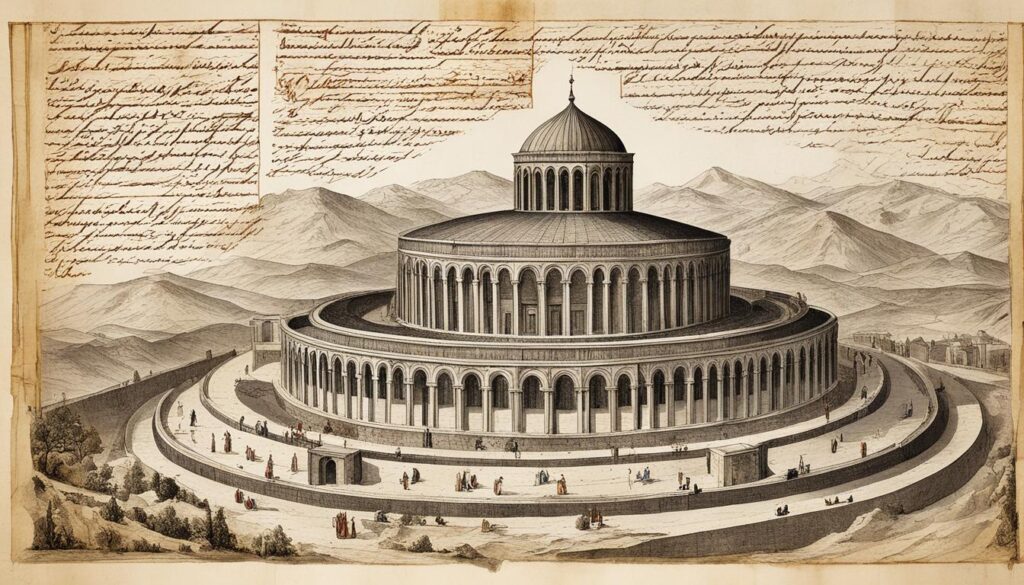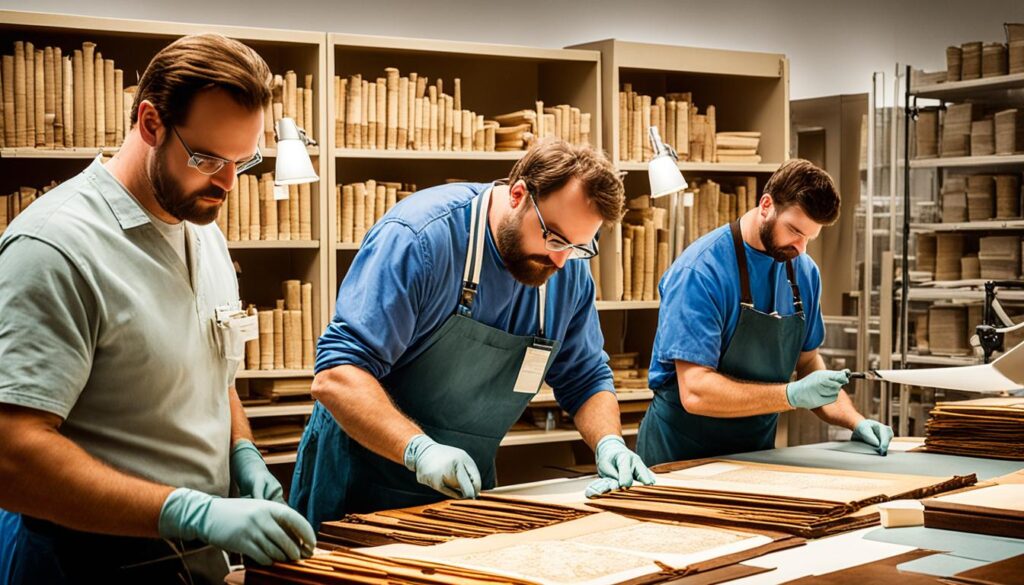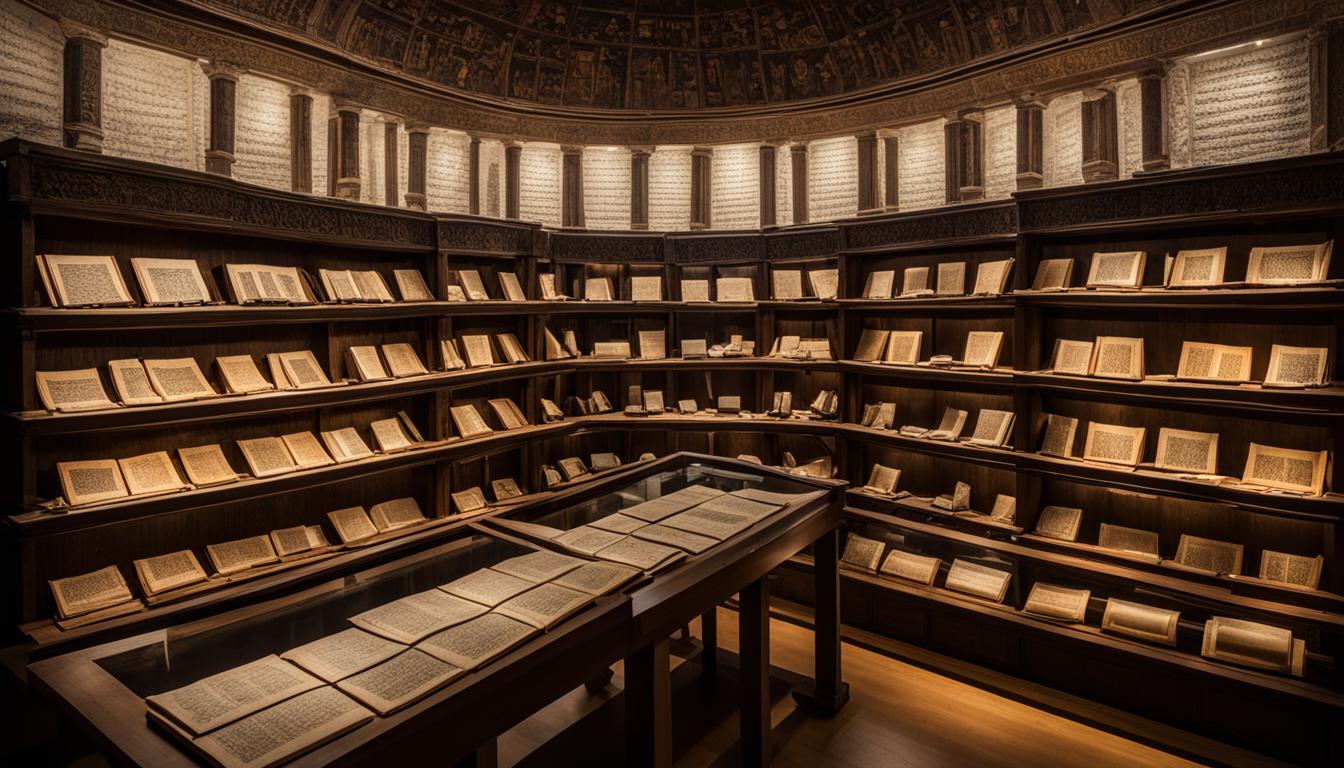Did you know that the Matenadaran in Yerevan, Armenia houses the world’s largest repository of ancient Armenian manuscripts? This impressive collection of over 23,000 scrolls and texts has become a treasure trove for scholars and historians, shedding light on Armenia’s rich literary and cultural heritage.
Established in 1959, the Matenadaran has evolved into a leading center for the study of ancient Armenian manuscripts, spanning a wide range of disciplines from paleography and calligraphy to medieval literature and historical artifacts. As a museum, archive, and research institute, this unique institution plays a vital role in preserving and understanding Armenia’s past through its exceptional collection of illuminated texts, medieval writings, and other priceless historical documents.
Key Takeaways:
- The Matenadaran in Yerevan, Armenia houses the world’s largest repository of ancient Armenian manuscripts, with over 23,000 scrolls and texts.
- Established in 1959, the Matenadaran is a leading center for the study of ancient Armenian manuscripts, covering a wide range of disciplines from paleography to medieval literature.
- The Matenadaran plays a vital role in preserving and understanding Armenia’s rich cultural and literary heritage through its exceptional collection of illuminated texts and historical documents.
- The Matenadaran’s collection includes medieval Armenian literature, calligraphy, and artifacts from the Cilician period and the Vaspurakan school.
- The Matenadaran’s research and conservation efforts have made it a crucial institution for the study of Armenian history and culture.
Armenia: Ancient manuscript studies Yerevan Armenia
Armenia has a rich and storied history of manuscript studies, with the renowned Matenadaran in Yerevan serving as the centerpiece of this long-standing tradition. The earliest records of a manuscript repository in Armenia date back to the 5th century, when the historian Ghazar Parpetsi documented the existence of a collection at the Etchmiadzin Catholicosate. Over the centuries, major Armenian monasteries became hubs for preserving thousands of ancient texts, safeguarding this invaluable cultural heritage amidst various invasions and conflicts.
The Matenadaran, established in 1959, was created to consolidate and safeguard Armenia’s expansive manuscript legacy, building upon the foundations laid by its historic predecessors. This renowned institution has become a center of research and study, attracting scholars from around the world who delve into the mysteries of Armenian literature, calligraphy, medieval manuscripts, and the rich Cilician period of Armenian history. Through its meticulous paleographic analyses and preservation efforts, the Matenadaran continues to shed light on the intellectual and artistic brilliance of the Vaspurakan school and other influential centers of Armenian manuscript studies.
The Matenadaran: A Treasure Trove of Armenian Manuscripts
The Matenadaran in Yerevan, Armenia, is a remarkable institution that houses one of the world’s most significant collections of ancient Armenian manuscripts. Established in 1959, the Matenadaran traces its roots back to the Armenian Church’s repository at Etchmiadzin, which faced numerous threats and pillaging over the centuries, losing thousands of invaluable manuscripts during the Turkic and Mongol invasions.
History and Establishment of the Matenadaran
The Matenadaran was officially established by the Soviet Armenian government as an “institute of scientific research,” consolidating the nationalized manuscript collection from Etchmiadzin. This centralization was a crucial step in preserving Armenia’s cultural heritage, which had been under threat during the Sovietization of the region.
Architectural Significance and Design Inspiration
The Matenadaran’s current building, designed by architect Mark Grigorian and completed in 1958, is renowned for its architectural significance. Inspired by medieval Armenian structures like the 12th century Church of the Holy Apostles in Ani and the Geghard Monastery, the Matenadaran’s monumental, temple-like facade has been described as a “modern temple to Armenian civilization.” The building’s design seamlessly blends traditional Armenian architectural elements with a modern aesthetic, creating a striking and visually captivating structure that serves as a fitting home for the Matenadaran’s invaluable manuscript collection.

Collections and Exhibitions at the Matenadaran
The Matenadaran, a renowned repository of Armenian cultural heritage, has amassed an impressive collection of over 23,000 manuscripts and scrolls, along with more than 500,000 archival documents. This vast trove of Armenian artifacts has been carefully curated and exhibited to showcase the country’s rich intellectual and literary tradition.
Manuscripts from the Armenian Genocide
Among the Matenadaran’s most poignant holdings are the manuscripts and documents that were salvaged from the devastation of the Armenian Genocide. These rare and fragile materials serve as a powerful testament to the resilience of Armenia’s cultural legacy, even in the face of unspeakable tragedy. Visitors can discover the stories behind these precious artifacts and gain a deeper understanding of the Armenian people’s enduring spirit.
Medieval Armenian Medicine and Artifacts
The Matenadaran’s exhibitions also feature a wealth of manuscripts and artifacts related to medieval Armenian medicine. Visitors can marvel at ancient medical treatises, rare books, and illuminated texts that provide insight into the country’s rich intellectual tradition. These historical materials offer a glimpse into the sophisticated medical practices and scientific knowledge that flourished in Armenia during the Middle Ages.
The Matenadaran’s comprehensive collections and meticulously curated exhibitions have made it a premier destination for those interested in Armenian culture, history, and the preservation of ancient manuscripts. Through these efforts, the museum ensures that the Matenadaran’s vast holdings continue to inspire and educate visitors from around the world.
Preserving Cultural Heritage through Manuscript Studies
At the heart of the Matenadaran, Armenia’s renowned manuscript repository, lies a steadfast commitment to preserving the country’s rich cultural heritage. As a leading research institute, the Matenadaran hosts scholars from around the world who come to examine the ancient texts, fragments, and documents housed within its walls. Through meticulous preservation efforts and ongoing research, this institution ensures that this invaluable repository of Armenian cultural heritage remains accessible to future generations.
The Matenadaran’s unwavering dedication to manuscript preservation fosters a deeper understanding of Armenia’s past and its enduring cultural significance. Scholars from around the world flock to this esteemed institution to delve into the vast trove of Armenian studies materials, uncovering insights that shed light on the country’s rich history and literary traditions.
By meticulously preserving these ancient manuscripts and facilitating ongoing research, the Matenadaran plays a pivotal role in safeguarding Armenia’s cultural legacy for generations to come. Through this vital work, the institution ensures that the invaluable knowledge and artistic expressions captured in these manuscripts continue to inspire and enlighten scholars, students, and the global community alike.
Illuminated Manuscripts and Armenian Calligraphy
The Matenadaran, Armenia’s renowned repository of ancient manuscripts, houses an impressive collection of illuminated texts that showcase the rich tradition of Armenian calligraphy and manuscript illumination. Visitors to this historic institution can marvel at the intricate designs and vibrant colors that adorn these rare and precious manuscripts, many of which were produced by master illuminators like Toros Roslin during the Cilician period.
The Matenadaran’s exhibitions and displays highlight the artistic accomplishments of these skilled artisans, whose works have become emblematic of Armenia’s cultural heritage. Through the preservation and study of these illuminated manuscripts, the Matenadaran continues to inspire a deeper appreciation for the artistry and craftsmanship that defined Armenia’s medieval manuscript tradition.
Prominent Illuminators and Their Works
Among the Matenadaran’s most celebrated illuminators is Toros Roslin, a prolific artist who played a pivotal role in shaping the distinctive style of Armenian manuscript illumination. Roslin’s works, characterized by their intricate motifs, vibrant colors, and meticulous attention to detail, have become iconic representations of the Matenadaran’s collection and Armenia’s artistic legacy.
By preserving and showcasing these masterpieces of Armenian calligraphy and manuscript illumination, the Matenadaran continues to honor the artistic achievements of its past while inspiring a new generation of scholars, artists, and enthusiasts to explore and appreciate the rich tapestry of Armenia’s cultural heritage.
The Matenadaran’s Role in Armenian Literature and History
The Matenadaran, the renowned manuscript repository in Yerevan, Armenia, serves as a vital institution for preserving and promoting the country’s rich literary and historical legacy. This vast collection of ancient texts provides an invaluable resource for scholars studying the intellectual tradition of medieval Armenia, from philosophy and cosmology to jurisprudence and poetry.
As a research institute, the Matenadaran supports in-depth investigations into the contributions of influential Armenian figures, such as Mesrop Mashtots, the inventor of the Armenian alphabet. Mashtots’ statue stands prominently in front of the Matenadaran building, a testament to the institution’s commitment to honoring and preserving the country’s cultural heritage.
Through its exhibitions and educational programs, the Matenadaran explores the enduring significance of these ancient manuscripts, shedding light on Armenia’s literary and historical narrative. By safeguarding and promoting the study of these precious documents, the institution plays a pivotal role in shaping our understanding of the country’s vibrant cultural history.

International Collaborations and Conferences
The Matenadaran, Armenia’s renowned manuscript repository, extends its influence far beyond the country’s borders through its active engagement in international collaborations and prestigious academic conferences. One such event that draws the world’s top Armenologists and medievalists is the biennial International Armenological Congress, hosted at the Matenadaran and other sites across Armenia.
The International Armenological Congress
This prestigious gathering provides a platform for the exchange of groundbreaking research and the exploration of Armenia’s rich cultural heritage. Scholars from around the globe convene at the Matenadaran to present their latest findings, fostering a dynamic dialogue that furthers the understanding of Armenian studies. The Matenadaran’s international collaborations also extend to joint research projects and the facilitation of manuscript studies, strengthening academic ties and promoting the global dissemination of knowledge about this invaluable collection.
Through its active involvement in these international endeavors, the Matenadaran continues to cement its position as a leading center for the study and preservation of Armenian manuscripts, solidifying its reputation as a hub for Armenological research and collaboration.
Digitization and Virtual Exploration of Manuscripts
In the digital age, the Matenadaran in Yerevan, Armenia, has embraced innovative approaches to preserving and sharing its vast collection of ancient manuscripts. Through extensive manuscript digitization efforts, this esteemed institution has made its cultural treasures more accessible to scholars and the public alike.
The Matenadaran’s commitment to digital preservation has enabled virtual exhibitions, allowing visitors from around the world to explore these rare Armenian manuscripts in unprecedented detail. By leveraging cutting-edge technology, researchers can now study the intricate calligraphy, illuminations, and historical significance of these priceless artifacts without the need for physical access.
This digital initiative not only facilitates scholarly research but also helps safeguard the fragile manuscripts, ensuring their longevity for future generations. By making the Matenadaran’s collection available online, the institution has expanded its reach and deepened the global understanding of Armenia’s rich literary and cultural heritage.

Through innovative digital platforms and virtual exhibitions, the Matenadaran continues to lead the way in the preservation and dissemination of its invaluable manuscript collection. This ongoing commitment to manuscript digitization and virtual exploration demonstrates the institution’s dedication to sharing Armenia’s cultural treasures with the world.
Educational Programs and Outreach Initiatives
The Matenadaran, Armenia’s renowned manuscript repository, takes great pride in its unwavering commitment to preserving and promoting the country’s rich cultural heritage. This dedication extends beyond the physical preservation of ancient manuscripts, as the institution actively engages the public through a diverse range of educational programs and outreach initiatives.
Visitors to the Matenadaran can immerse themselves in guided tours, workshops, and specialized academic courses that delve into the significance and intricacies of the manuscript collection. These programs cater to audiences of all ages and backgrounds, fostering a deeper appreciation for the Matenadaran’s invaluable role in safeguarding Armenian cultural heritage.
Beyond its walls, the Matenadaran actively collaborates with schools, universities, and international organizations to develop innovative educational resources and facilitate cross-cultural exchanges. These outreach initiatives ensure that the richness of Armenian manuscripts and studies is shared with a global audience, promoting a greater understanding and celebration of this ancient and revered tradition.
Through its comprehensive educational programs and outreach efforts, the Matenadaran continues to play a pivotal role in safeguarding and disseminating the invaluable knowledge contained within its walls, ensuring that Armenia’s cultural legacy remains a vibrant and accessible part of the world’s shared heritage.
Ongoing Restoration and Conservation Efforts
At the heart of the Matenadaran’s mission lies a steadfast commitment to preserving Armenia’s rich cultural heritage. The institution’s team of skilled experts undertakes a meticulous and ongoing process of manuscript restoration and conservation, ensuring the longevity of these priceless ancient texts. From carefully stabilizing and repairing damaged pages to developing specialized storage and display methods, the Matenadaran’s dedication to safeguarding its collection is unwavering.
Preserving Ancient Manuscripts for Future Generations
By investing in these preservation initiatives, the Matenadaran is ensuring that Armenia’s cultural legacy will be accessible to future generations, inspiring continued research, study, and appreciation of these invaluable manuscripts. Traditional restoration techniques are combined with modern technologies, allowing the institution to meticulously restore and conserve the Matenadaran’s treasured collection of Matenadaran manuscripts, manuscript restoration, and manuscript conservation. This commitment to cultural heritage preservation ensures that Armenia’s literary and historical legacy will be safeguarded for centuries to come.

Conclusion
The Matenadaran in Yerevan, Armenia stands as a remarkable institution that serves as the world’s largest repository of ancient Armenian manuscripts. Through its impressive collection, groundbreaking research, educational programs, and international collaborations, the Matenadaran has become a hub for the preservation and study of Armenia’s rich cultural heritage.
As a museum, archive, and research institute, the Matenadaran plays a vital role in ensuring that the country’s literary and historical legacy continues to be celebrated and shared with audiences around the globe. By embracing the digital age while upholding traditional preservation methods, the Matenadaran remains steadfast in its mission to safeguard Armenia’s priceless Matenadaran for generations to come.
The Matenadaran’s unwavering dedication to the preservation of Armenian cultural heritage and the advancement of manuscript studies in Yerevan, Armenia serves as a testament to the enduring importance of these ancient artifacts. Through its multifaceted approach, the institution continues to inspire and educate people worldwide, ensuring that the rich tapestry of Armenia’s history and literature remains an integral part of the global cultural landscape.
Source Links
- Matenadaran – https://en.wikipedia.org/wiki/Matenadaran
- Home – https://matenadaran.am/en/matenadaran/home/
- Museum of The Matenadaran – https://matenadaran.am/en/matenadaran/museum-and-gallery/museum-of-matenadaran/


